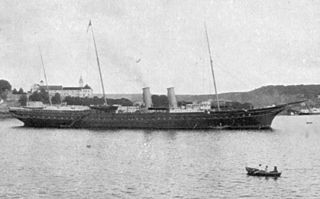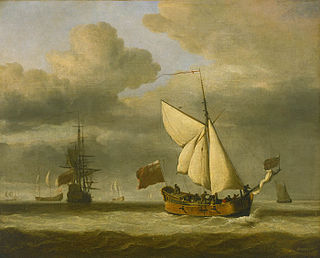
Her Majesty's Yacht Britannia, also known as the Royal Yacht Britannia, is the former royal yacht of the British monarch, Queen Elizabeth II, in service from 1954 until 1997. She was the 83rd such vessel since King Charles II acceded to the throne in 1660, and is the second royal yacht to bear the name, the first being the racing cutter built for the Prince of Wales in 1893. During her 43-year career, the yacht travelled more than a million nautical miles around the globe. Now retired from royal service, Britannia is permanently berthed at Ocean Terminal, Leith in Edinburgh, Scotland. It is a popular visitor attraction with over 300,000 visits each year.
Six ships and a shore establishment of the Royal Navy have borne the name HMS Britannia, after Britannia, the goddess and personification of Great Britain:
Eight ships of the Royal Navy have been named HMS Royal George after various members of the House of Hanover. A ninth was renamed before being launched:

HMY Victoria and Albert was a twin-paddle steamer launched 25 April 1843. She functioned as a royal yacht of the sovereign of the United Kingdom, owned and operated by the Royal Navy, and was the first of three royal yachts to be named Victoria and Albert. She was laid down in 1842 at Pembroke Dock and was designed by William Symonds. She measured 1,034 tons burthen, carried two guns, and was the first royal yacht to be steam powered, being fitted with a 430 horsepower (320 kW) engine.

HMY Victoria and Albert was a royal yacht of the Royal Navy of the United Kingdom. The yacht was designed by the Chief Constructor of the Royal Navy Sir William White, launched in 1899 and ready for service in 1901. This was the third yacht to be named Victoria and Albert and she was fitted with steam engines fired by Belleville water-tube boilers. She served four sovereigns, and was decommissioned as royal yacht in 1939, served in the Second World War, and was broken up in 1954.

HMY Osborne was a paddle steamer Royal Yacht of the Royal Navy of the United Kingdom. Designed by Edward James Reed, she was launched on 19 December 1870 at Pembroke Royal Dockyard and replaced the yacht of the same name formerly known as HMY Victoria and Albert.

HMY Fubbs was a Royal Yacht of the Royal Navy of the Kingdom of Great Britain. She was scrapped towards the end of the eighteenth century after having been in service for 99 years.
Six ships of the Royal Navy have borne the name HMS Windsor Castle, after Windsor Castle, an official residence of the British monarch:

HMY Royal Caroline was a ship-rigged royal yacht. She was ordered in 1749 to replace HMY Carolina as Britain's principal royal yacht. She was built at Deptford Dockyard under the supervision of Master Shipwright John Hollond to a design by Surveyor of the Navy Joseph Allin. She was launched on 29 January 1750 and was broken up 70 years later, in 1820.
Six vessels of the Royal Navy have borne the name HMSRoyal Charlotte, after Charlotte of Mecklenburg-Strelitz, consort of King George III.
Fifteen ships of the Royal Navy have borne the name HMS Mary:
HMY Osborne is the name of two British Royal Yachts:

HMY Royal Escape was a royal yacht used by King Charles II. She was a former collier in coastal trade named Surprise.
Eight ships of the Royal Navy have borne the name HMS Augusta or HMS Auguste, whilst another two were planned:
Fourteen ships and one shore establishment of the Royal Navy have borne the name HMS Merlin, after Merlin, the wizard in Arthurian legend :
Britannia may refer to any one of a large number of ships:
Three British Royal Yachts have been named HMY Victoria and Albert after the British Monarch and her husband:
Several ships of the Royal Navy have been named HMS Fairy:

Edward Knowles was an officer of the Royal Navy, who saw service during the Seven Years' War.

HMS Peregrine Galley was a 20-gun sixth-rate ship of the Royal Navy, built in 1699-1700 at Sheerness Dockyard by Master Shipwright William Lee to a design by Rear-Admiral the Marquis of Carmarthen. She was generally employed as a Royal yacht and in 1716 she was officially renamed HMS Carolina and converted to a permanent Royal yacht. In May 1733 she was rebuilt by Richard Storey at Deptford Dockyard as the Royal yacht and again renamed, this time as Royal Caroline. In 1739 she ceased to be the Royal yacht and resumed her classification as a Sixth Rate. In 1749 a new Royal Caroline was built to replace her. She reverted to being a naval sloop under the name HMS Peregrine and served until her loss on or about 28 December 1761.
This page is based on this
Wikipedia article Text is available under the
CC BY-SA 4.0 license; additional terms may apply.
Images, videos and audio are available under their respective licenses.








